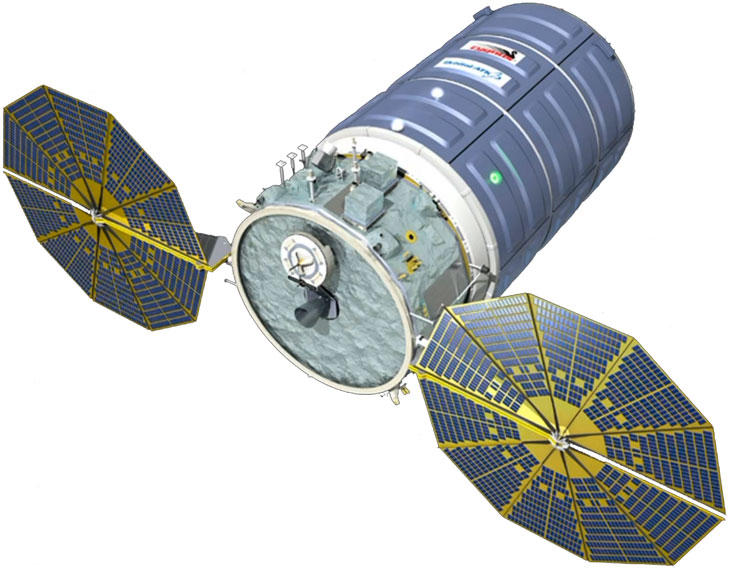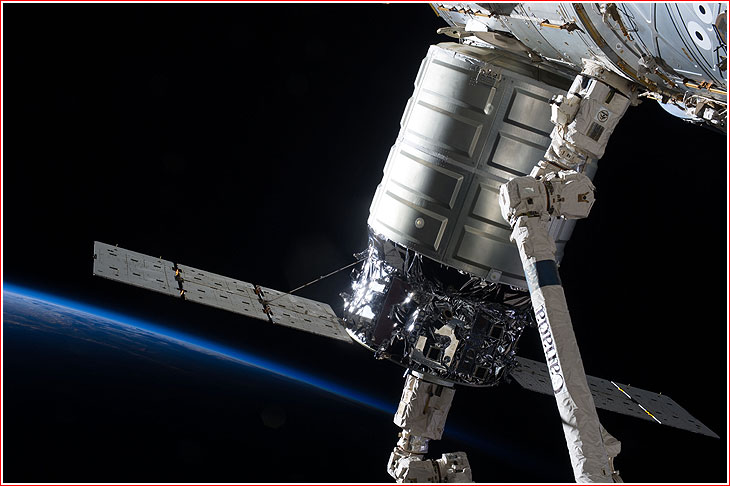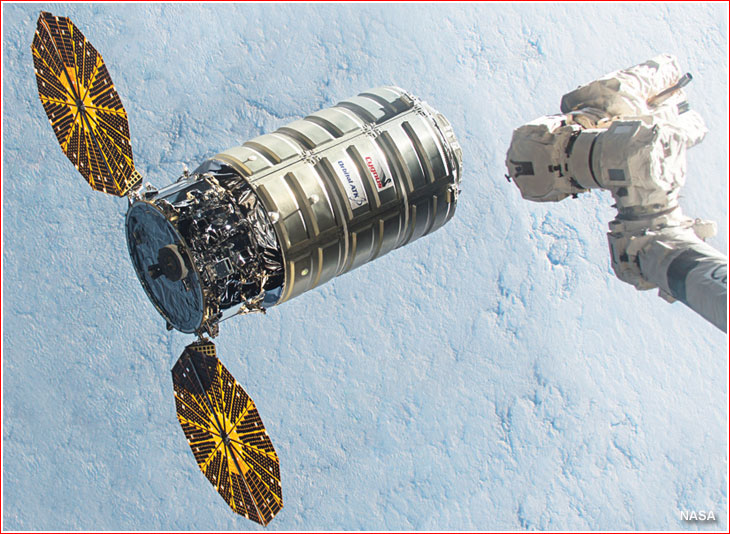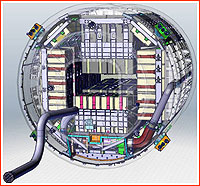The Cygnus cargo ship (original) (raw)
Cygnus cargo ship
Developed by the Orbital Sciences Corporation, OSC, (now Orbital ATK), the Cygnus cargo ship became an unglamorous replacement for the Space Shuttle, or at least for its role of delivering cargo to the International Space Station, ISS.
Previous chapter: Antares rocket

The Cygnus spacecraft at a glance:
| Liftoff mass | 6,173 kilograms |
|---|---|
| Ascent cargo mass | 2,425 - 3,515 kilograms |
| Descent cargo mass | 1,687 kilograms |
| Onboard propellant mass | 800 kilograms |
| Pressurized volume | 27 cubic meters |
| Length | 6.39 meters |
| Power supply system | Two fixed "UltraFlex" solar panels, ZTJ gallium arsenide cells |
| Power supply | 3,500 Watts (32 Volts in the main bus) |
| Power for hosted payloads | 1,300 Watts |
| Battery capacity | 20,262 Watt-hours |
| Onboard propellant | Nitrogen Tetroxide and 2H4/Mon-3 or N2H4 |
| Flight duration | 90 days (extendable up to a year after primary mission) |
| Docking system | Node 2 Common Berthing Mechanism, CBM |
| Launch vehicle | Antares-230 |
From the publisher: Pace of our development depends primarily on the level of support from our readers!
CRS contract
For the CRS-1 contract Orbital ATK promised to deliver approximately 30,000 kilograms of cargo to the ISS, and dispose of ISS waste, using Cygnus spacecraft. In 2016, Orbital ATK quoted six planned missions to the ISS through 2018 and under a second NASA contract -- CRS2 -- for another six missions, beginning in 2019. According to the company, a total of more than 50 tons of cargo would be delivered to the ISS from 2013 to 2024.
In addition to its cargo-delivery role, Orbital ATK pitched the vehicle to commercial users for a variety of tasks, such as launching small satellites and conducting experiments in microgravity.
Cygnus design

Astronauts onboard the International Space Station use a robotic arm to attach the first Cygnus cargo ship to the US segment of the station in 2013. Credit: NASA

An upgraded version of the Cygnus cargo ship.
The Cygnus cargo ship can accommodate up to 3,515 kilograms of supplies in its Pressurized Cargo Module, PCM. The pressurized section is manufactured by Thales Alenia Space in Turin, Italy, and based on the company's Multi-Purpose Logistics Module, MPLM, which was carried in the Space Shuttle's cargo bay to resupply the International Space Station.
The same company also built similar barrel-shaped structures for the Space Shuttle's Spacelab and Spacehab modules and for the European Columbus module.
For the first three CRS missions, a standard PCM was employed to carry up to 2,300 kilograms of cargo. The
enhanced PCM designed to carry up to 3,500 kilograms of cargo was to be used in CRS missions four through eight.
The service module for the spacecraft is manufactured by Orbital ATK in Dulles, Virginia. The service module incorporates avionics systems from Orbital ATK’s flight-proven LEOStar and GEOStar satellite series. The ship's propulsion and power systems were also borrowed from GEOStar communications satellites.
To control Cygnus flights in orbit, Orbital ATK set up mission control in Dulles, Va, which works in cooperation with NASA's main mission control at Johnson Space Center, JSC, in Houston, TX.
Flight profile
After several days in solo flight, Cygnus automatically approaches the ISS up to a distance of 12 meters with the help of satellite navigation and laser imaging. The ISS crew then uses the station's robotic arm to grab the ship and dock it to the US segment.
The ship can remain attached to the ISS for a period of up to 90 days, after which it is released in orbit for a destructive reentry into the Earth's atmosphere.
A complete list of Cygnus missions:
| - | Launch date | Time of launch | Payload | Launch vehicle | Status |
|---|---|---|---|---|---|
| 1 | 2013 April 21 | 5 p.m. EDT | Cygnus mass simulator, DOVE-1, PhoneSat v1a, PhoneSat v1b, PhoneSat v1c | Antares-110 | Success |
| 2 | 2013 Sept. 18 | 10:58:02 a.m. EDT | Cygnus Orb-D1 (COTS Demo) | Antares-110 | Success |
| 3 | 2014 Jan. 9 | 1:07:05 p.m. EST | Cygnus (Orb-1) | Antares-120 | Success |
| 4 | 2014 July 13 | 12:52 p.m. EDT | Cygnus Orb-2 (CRS-2) | Antares-120 | Success |
| 5 | 2014 Oct. 28 | 6:22:38 p.m. EDT | Cygnus Orb-3 (CRS-3) | Antares-130 | Failure |
| 6 | 2015 Dec. 6 | 4:44:57 p.m. EST | Cygnus OA-4 (CRS4) (enhansed) | Atlas-5 (401/AV-061) | Success |
| 7 | 2016 March 22 | 11:05 p.m. EDT | Cygnus OA-6 (CRS6) (enhansed) | Atlas-5 (401/AV-064) | Success |
| 8 | 2016 Oct. 17 | 7:45:40 p.m. EDT | Cygnus CRS OA-5 (Alan Poindexter) | Antares-230 | Success |
| 9 | 2017 Nov. 12 | 7:19:55 a.m. EST | Cygnus CRS-8 OA-8 | Antares-230 | Success |
| 10 | 2018 May 21 | 4:44:09.7 a.m. EDT | Cygnus OA9 (CRS-9) | Antares-230 | Success |
| 11 | 2018 Nov. 17 | 4:01 a.m. EST | Cygnus-10 (CRS-10, NG-10, John Young) | Antares-230 | Success |
| 12 | 2019 April 17 | 4:46 p.m EDT | Cygnus NG-11 (CRS-11, Roger Chaffee) | Antares-230 | Success |
| 13 | 2019 Nov. 2 | 9:59 a.m. Eastern Time | Cygnus NG-12 (CRS-12, Alan Bean) | Antares-230+ | Success |
| 14 | 2020 Feb. 15 | 3:21:04.9 p.m. EST | Cygnus NG-13 (CRS-13, S.S. Robert Lawrence, Jr.) | Antares-230+ | Success |
| 15 | 2020 Oct. 2 | 9:16:14 p.m. EDT | Cygnus NG-14 (CRS-14, S.S. Kalpana Chawla) | Antares-230+ | Success |
| 16 | 2021 Feb. 20 | 12:36 p.m. EST | Cygnus NG-15 (CRS-15, S.S. Kathrine Johnson) | Antares-230+ | Success |
| 17 | 2021 Aug. 10 | 6:01:09.300 p.m. EDT | Cygnus NG-16 (CRS-16, Onizuka) | Antares-230+ | Success |
| 18 | 2022 Feb. 19 | 12:40 p.m. EST | Cygnus NG-17 (CRS-17, S.S. Piers Sellers) | Antares-230+ | Success |
| 19 | 2022 Nov. 7 | 5:32:42 a.m. EDT | Cygnus NG-18 (CRS-18, S.S. Sally Ride) | Antares-230+ | Success |
| 20 | 2023 Aug. 1 | 8:31:14 p.m. EDT | Cygnus NG-19 (CRS-19, S.S. Laurel Clark) | Antares-230+ | Success |
| 21 | 2024 Jan. 30 | 12:07 p.m. EST | Cygnus NG-20 (CRS-20, S.S. Patricia (Patty) Hilliard Robertson) | Falcon-9 | Success |
| 22 | 2024 Aug. 4 | 11:02 a.m. EDT | Cygnus NG-21 (CRS-21, S.S. Francis R. "Dick" Scobee) | Falcon-9 | Success |
| 23 | 2025 Sept. 14 | 6:11 p.m. EDT | Cygnus NG-23 (CRS-23, S.S. Willie McCool) | Falcon-9 | Success |
This page is maintained by Anatoly Zak; Last update:September 14, 2025
All rights reserved

Internal layout of the Pressurized Cargo Module, PCM, for the Cygnus spacecraft. Credit: Orbital
An Antares rocket lifts off in on July 13, 2014, with the CRS Orb-2 cargo supply mission to the ISS. Click to enlarge. Credit: BIll Ingalls / NASA

Original version of Cygnus spacecraft. Credit: NASA
Orbital ATK's Cygnus cargo craft is released from the International Space Station in this June 14, 2016, photograph by ESA astronaut Tim Peake. Once Cygnus reached a safe distance, ground controllers at NASA's Glenn Research Center initiated the sequence for an experiment design to better understand how fire spreads in a microgravity environment. Credit: NASA

)
)